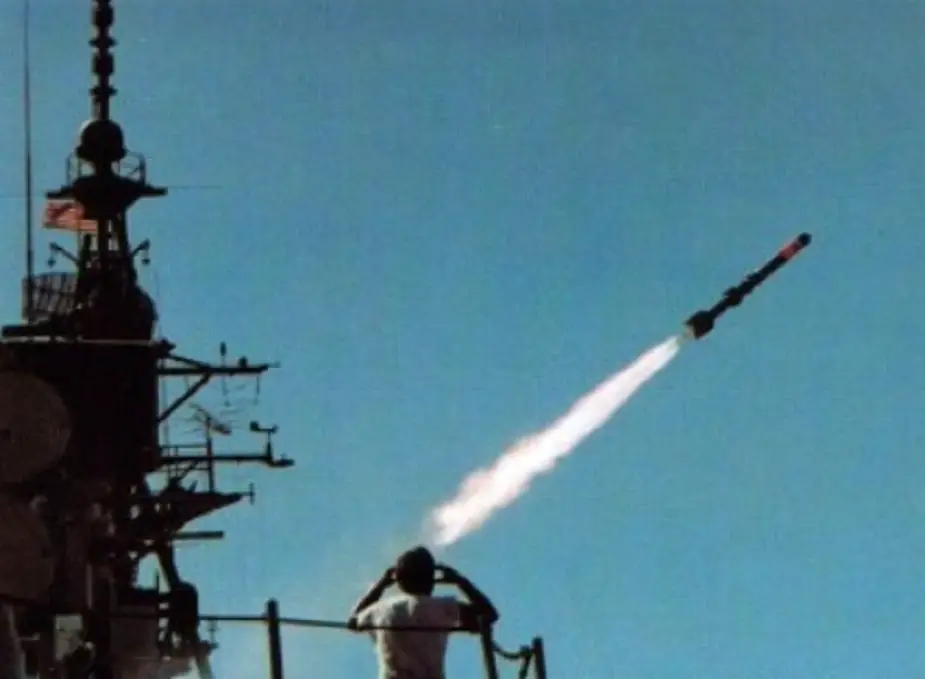The Russian Navy will receive for service an essentially new anti-submarine guided missile (ASGM). It enables killing submarines at a distance of up to tens of kilometres from warships. The ASGM operating pattern is fairly simple. A patrol aircraft or helicopter detects a submarine in a real time mode and provides a target designation. Further on, a missile is launched from the ship to the designated area where the target is destroyed, the Izvestia newspaper reports.
 The first such weapon, RUR-5 ASROC (Anti-Submarine ROCket) was developed by Americans in 1961. Its operating range was limited by the operating range of the then sonars, not exceeding ten kilometres. (Picture source: US Navy)
The first such weapon, RUR-5 ASROC (Anti-Submarine ROCket) was developed by Americans in 1961. Its operating range was limited by the operating range of the then sonars, not exceeding ten kilometres. (Picture source: US Navy)
The new product is in a condition of high readiness, sources at the Navy High Command told the news agency. The modern antisubmarine missile is placed in a multipurpose transport-and-launch container. This contains two modules, starting and operational control plus a power supply source and an array of support systems. The head of the missile launched into the enemy submarine area contains a small-sized torpedo. On entering the prescribed area it separates from the carrier, after which it independently finds and hits the submarine.
Antisubmarine missiles are the most dangerous weapons against subs, assures Admiral Valentin Selivanov, ex-head of the Navy General Headquarters. "Modern antisubmarine missiles have two chief strong points - long range and high efficiency. The assured kill probability by this type of weapon exceeds 90%. The inevitable death of a submarine can only be thwarted by a technical fault of the munition or a mistake of the ship’s operator who erroneously located the enemy. However, our sailors committed no such errors during practice firings which I attended," he said. Depth bombs are not a particularly precise weapon and they are used for areal engagement.
Antisubmarine torpedoes have roughly the same target kill efficiency as ASGM, but their operating range is much shorter, the expert noted. In developing the new missile the latest engineering achievements were used. The container layout makes it possible to install ASGMs on shorelines, at naval bases, on combat and other ships, as well as railway and truck platforms. Preparation of the transport-an-launch container for firing takes just a few seconds, the entire system is simple to use.
Ships are supposed to become the main ASGM platform. The guided missile can be integrated in ships’ and even mixed aircraft and ship formations’ automatic control system. This enables using fixed- and rotary-wing aircraft as reconnaissance aerial platforms that detect submarines and provide target designation to ships armed with the new weapon.
The antisubmarine missile concept emerged in the late 1950s in the wake of rapid growth of the surface fleet. The submarines’ speed came close to and even exceeded that of surface ships. Thus approaching an object to be attacked became difficult.
That is why military sailors were anxious to receive a weapon that might virtually instantly hit a submarine several kilometres away from it. The first such weapon, RUR-5 ASROC (Anti-Submarine ROCket) was developed by Americans in 1961. Its operating range was limited by the operating range of the then sonars, not exceeding ten kilometres.
At roughly the same time the Soviet Navy, too, received antisubmarine systems with similar characteristics. By the mid-1980s their efficiency had grown significantly. In the final years of the USSR its ships and submarines were armed with the "Vodopad" torpedo tube-launched anti-sub missile systems that could assuredly hit submarines at a considerably longer range. The role of fixed- and rotary-wing aircraft that could detect submarines and assist ships in fighting them also rose in importance. The emergence of the new system will make life hard for a likely opponent. Dodging from anti-submarine missiles, especially ASFM, is extremely difficult, explained the expert Igor Kurdin. "The missiles are very fast," he told the Izvestia. "To avoid the sinking of the boat, its commander must hone his actions literally to automatism. He has practically no time for manoeuvring and using hydro-acoustic dodging systems and decoys."
© Copyright 2019 TASS. All rights reserved. This material may not be published, broadcast, rewritten or redistributed.



